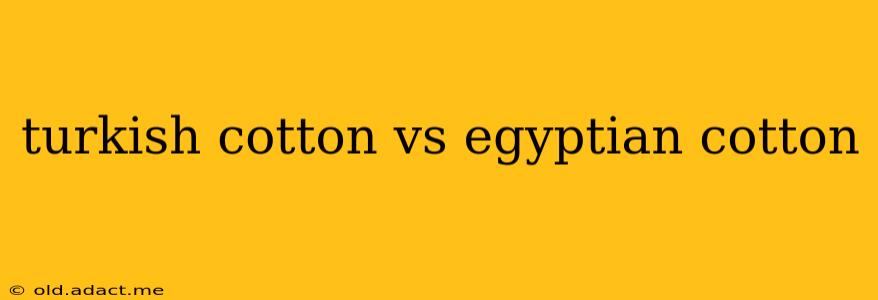Choosing the right bedding can significantly impact your sleep quality and overall comfort. Two names consistently top the list of luxurious cotton options: Turkish and Egyptian cotton. But what sets them apart? This in-depth comparison will explore the key differences between Turkish and Egyptian cotton, helping you make an informed decision for your next purchase.
What Makes Egyptian Cotton So Famous?
Egyptian cotton's reputation for luxury is well-earned. Its long staple fibers (typically exceeding 1 3/8 inches) contribute to its exceptional softness, strength, and durability. These long fibers create a smoother, more lustrous fabric with fewer imperfections, resulting in a remarkably soft feel against the skin. The longer fibers also intertwine more tightly during weaving, creating a stronger, more durable fabric that resists pilling and wear. This contributes to its high thread count, often exceeding 400 threads per square inch (TPI), further enhancing its softness and luxurious feel.
Understanding Turkish Cotton's Unique Qualities
Turkish cotton, while often compared to Egyptian cotton, possesses its own distinct characteristics. While the fiber length isn't as consistently long as Egyptian cotton, it still boasts a respectable length, frequently reaching lengths suitable for high-quality textiles. Turkish cotton is known for its exceptionally absorbent nature, making it ideal for towels and other absorbent textiles. Its strength and durability also contribute to its longevity, ensuring your bedding remains comfortable and intact for years. Furthermore, Turkish cotton is often praised for its surprisingly soft and luxurious feel, rivaling Egyptian cotton in many respects. The softness, however, may vary depending on the spinning and weaving processes employed.
Turkish Cotton vs Egyptian Cotton: Key Differences Summarized
| Feature | Egyptian Cotton | Turkish Cotton |
|---|---|---|
| Fiber Length | Generally longer (1 3/8 inches +) | Typically shorter, but still substantial |
| Softness | Exceptionally soft, supremely smooth | Very soft, often luxurious feel |
| Absorbency | High | Extremely High |
| Durability | Excellent, resists pilling and wear | Excellent, resists pilling and wear |
| Thread Count | Often higher (400 TPI and above) | Can be high, but varies more widely |
| Price | Typically more expensive | Generally more affordable |
| Lustre | Higher | Moderate |
What is the Difference in the Feel?
Both Egyptian and Turkish cotton are known for their softness, but the difference lies in the type of softness. Egyptian cotton tends to have a more luxurious, almost silky smoothness, while Turkish cotton offers a cloud-like, plush softness. This difference is largely due to the fiber length and the manufacturing processes used. Ultimately, personal preference plays a significant role in deciding which feels better.
Which is More Durable?
Both Egyptian and Turkish cotton are renowned for their durability. However, Egyptian cotton's longer fibers typically result in a slightly stronger and more resilient fabric. This means Egyptian cotton bedding might last a bit longer, especially with frequent washing and use. That said, high-quality Turkish cotton is also very durable and will provide years of comfortable use.
Which is Better for Towels?
Turkish cotton's exceptional absorbency makes it a superior choice for towels. Its ability to soak up water quickly and efficiently is unmatched, making for a more efficient and pleasant drying experience. While Egyptian cotton towels are certainly absorbent, they don't quite reach the same level as their Turkish counterparts.
Which Cotton Type is Right For Me?
The "best" cotton depends entirely on your priorities and budget.
- Choose Egyptian Cotton if: You prioritize exceptional smoothness, a luxurious feel, and are willing to pay a premium for top-tier quality.
- Choose Turkish Cotton if: You value superior absorbency, a still-luxurious yet more affordable option, and a slightly more plush feel.
Ultimately, both Egyptian and Turkish cotton offer exceptional quality and will provide years of comfortable use. Reading detailed product descriptions and considering your priorities will guide you toward the perfect choice for your bedding and bath needs.
